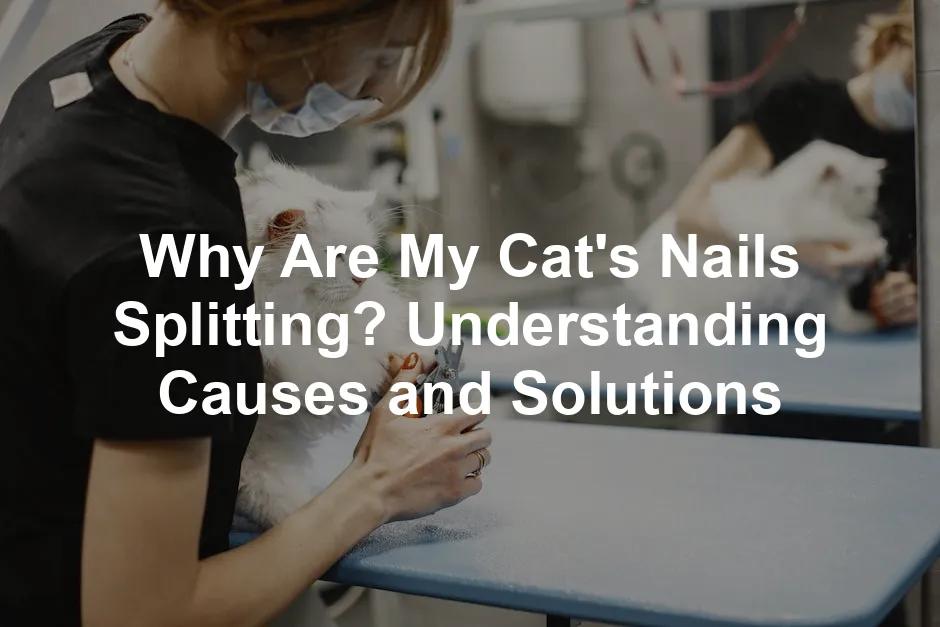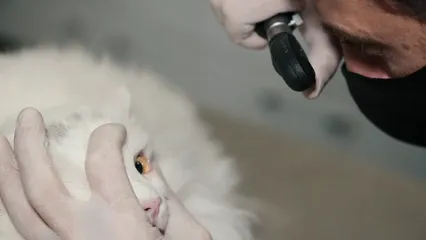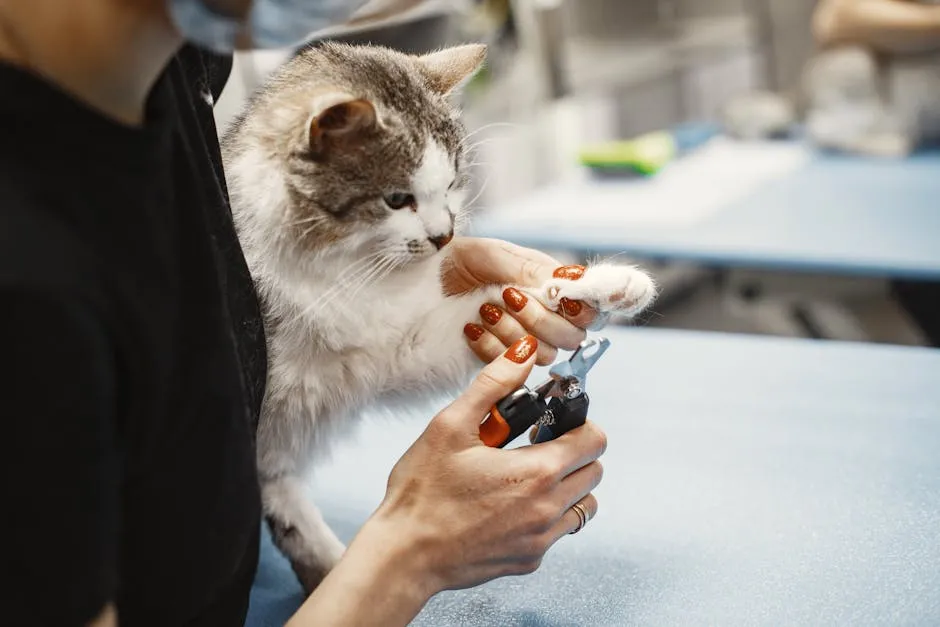
Why Are My Cat’s Nails Splitting? Understanding Causes and Solutions
Introduction
Noticing your cat’s nails splitting can be worrying. It’s a common concern among cat owners. Splitting nails can lead to discomfort and even pain for your furry friend. Understanding why this happens is crucial for their well-being. Let’s explore the reasons behind nail splitting and how to address this issue.
And speaking of keeping those claws in check, consider investing in a reliable Cat Nail Clippers. Sharp clippers make all the difference in ensuring a clean cut and avoiding painful splits.
Summary and Overview
Healthy nails are essential for your cat’s overall health. They help with grooming, climbing, and play. However, splitting nails can indicate underlying problems. Common causes include shedding, blunt clippers, and health issues. Regular grooming and veterinary visits are vital for maintaining nail health. By understanding the causes and potential treatments, you can ensure your cat’s paws stay healthy and strong. Let’s dive into the details of what causes nail splitting and how to prevent it.
While you’re at it, feed your feline friend a nutritious diet. High-quality food, like Royal Canin Feline Health Nutrition or Blue Buffalo Wilderness Cat Food, supports strong nails and overall health.
Common Causes of Nail Splitting in Cats
Shedding the Old Nail
Cats naturally shed the outer layer of their nails. This process can sometimes appear as splitting. Every two to three months, a cat’s claw grows, and the old layer cracks off. This shedding is essential for revealing new, healthier nails. You might notice this when your cat scratches surfaces around your home.
Blunt Nail Clippers
Using dull nail clippers can lead to painful splits. Blunt tools crush the nail instead of cutting cleanly. This can result in injury and even bleeding. Always ensure your clippers are sharp and well-maintained. Proper tools are crucial for safe and effective nail care.
In fact, if you’re looking for a great solution, consider the Cat Nail Trimmer. It’s designed to provide a clean cut every time, making nail care a breeze!

Aging Process
As cats age, their grooming habits often decline. They may not scratch as frequently, leading to unkempt nails. This neglect can result in splitting or breakage. Osteoarthritis is another common issue in older felines. This painful condition can make it difficult for them to maintain their nails. Reduced mobility may prevent them from using scratching posts effectively, leading to further nail health problems. Regular monitoring of older cats is crucial to ensure their nails remain in good condition.
Nail Biting or Chewing
Cats sometimes chew on their nails. This behavior might seem harmless but can indicate underlying issues. Nail biting can be a sign of boredom or stress. Cats may also chew nails to relieve discomfort caused by splits. Health problems, like ringworm or allergies, can lead to excessive grooming. If your cat is biting their nails frequently, it’s essential to evaluate their environment. Addressing stressors and providing mental stimulation is key to reducing anxiety-related habits.
Poor Health and Nutritional Status
Nail health reflects a cat’s overall well-being. If your cat has underlying health issues, it may show up in their nails. Conditions like diabetes or thyroid problems can lead to nail issues. Additionally, a poor diet can weaken nails, making them prone to splitting. Ensure your cat receives a balanced diet rich in essential nutrients. Foods high in protein and fatty acids can promote healthy nails, skin, and coat. Regular veterinary check-ups can help catch health issues before they escalate.

Also, consider adding some tasty treats to your cat’s diet to support dental health, such as Greenies Feline Dental Treats. They not only taste great but also help keep your cat’s teeth and nails healthy!
Nail Disorders
Various nail disorders can affect your cat’s claws. Infections, such as bacterial or fungal infections, can lead to splitting. Onycholysis, or the separation of the nail from its bed, is another concern. Tumors in the nail bed, though rare, can also cause issues. Regularly inspect your cat’s nails for signs of abnormalities. Look for swelling, redness, or discharge. If you notice any unusual changes, consult your veterinarian for a thorough evaluation. Early detection is key to effective treatment.

When to Consult a Veterinarian
Noticing your cat’s nails splitting can be concerning. It’s essential to recognize when it’s time to seek professional help. If you spot severe splits, especially those that cause bleeding, contact your veterinarian immediately. Bleeding nails can lead to infections if left untreated.
Moreover, if you notice your cat showing signs of pain, such as limping or excessive grooming of the affected paw, it’s a good idea to schedule a vet visit. Persistent nail splitting, despite at-home care, should also prompt a trip to the clinic. Your vet can help identify any underlying health issues that might be contributing to the problem.

Regular check-ups are vital for your cat’s well-being. They can catch early signs of health concerns before they escalate. Speaking of well-being, consider a PetSafe Healthy Pet Simply Feed Automatic Pet Feeder to ensure your cat is getting the right amount of food on schedule!
How to Treat Split Nails in Cats
Initial Assessment
Start by assessing the severity of the split nail. A minor split might not require immediate veterinary attention. Look for any signs of bleeding or deep cracks. If the nail is only slightly damaged and your cat seems comfortable, you can manage it at home. However, if the split is severe or if your cat shows discomfort, it’s best to consult a veterinarian for proper care.

Home Care Tips
For minor splits, follow these simple steps to treat your cat’s nails at home:
- Trim the Nail: Use sharp pet nail clippers to carefully remove any jagged edges. Avoid cutting too close to the quick, as this can cause pain and bleeding.
- Clean the Area: If the nail appears dirty or has minor bleeding, gently clean it with warm water and mild soap. This helps prevent infection.
- Apply Antiseptics: Use a pet-safe antiseptic to clean the area thoroughly. This can help ward off infection.
- Use Styptic Powder: If the nail is bleeding, apply styptic powder to stop the bleeding. This powder is a quick way to seal small cuts and prevent further issues.
- Monitor the Nail: Keep an eye on the affected nail for signs of infection, such as swelling or discharge. If anything seems off, reach out to your vet immediately.

Don’t forget, a FURminator deShedding Tool for Cats can help reduce shedding and keep your cat’s coat and nails in top condition!
When Professional Help is Necessary
Certain situations call for a veterinarian’s expertise. If the nail is deeply split, or if there’s significant bleeding that doesn’t stop with styptic powder, don’t hesitate to seek help. Your vet may need to bandage the nail or prescribe medications to ease pain and prevent infection.
Additionally, if you notice changes in your cat’s behavior, like increased hiding or reluctance to walk, these could be signs of pain. Regular vet visits can help manage ongoing issues and ensure your cat’s nails are healthy. Don’t wait too long if you’re unsure—better safe than sorry!

Preventive Measures for Healthy Cat Nails
Regular Nail Trimming
Keeping your cat’s nails trimmed is essential for their health. Regular nail maintenance prevents splits and painful injuries. Aim to trim your cat’s nails every 2-4 weeks. If you’re unsure how to do it, consider asking your veterinarian for guidance.

For at-home trimming, use sharp, quality clippers designed for cats. Start by gently pressing on the paw pad to extend the nail. Trim only the sharp tip, avoiding the pink area known as the quick. If you’re nervous, try trimming just one nail at a time, rewarding your cat with treats. If you prefer, professional groomers can help keep those claws in check.
Providing Appropriate Scratching Outlets
Scratching is a natural behavior for cats. It helps them shed the outer layers of their nails and keep them healthy. Providing scratching posts can significantly reduce nail splitting. Look for posts made of various materials, like sisal, cardboard, or carpet.

Speaking of scratching, consider the PetFusion Ultimate Cat Scratcher Lounge. It’s a stylish and functional addition to your cat’s play area!
Nutritional Considerations
A balanced diet plays a vital role in your cat’s overall health, including nail integrity. Ensure your cat eats high-quality food rich in protein and essential fatty acids. These nutrients support strong nails, skin, and a shiny coat.

Consider adding supplements like omega-3 fatty acids, which can improve nail health. Always consult your veterinarian before introducing new foods or supplements into your cat’s diet to ensure they’re safe and effective.
Conclusion
In summary, split nails in cats can be a common issue, but they can often be prevented with proper care. Regular trimming, providing scratching surfaces, and maintaining a balanced diet are key. Always monitor your cat’s nails and general health. If you notice persistent problems, don’t hesitate to consult your veterinarian for personalized advice and care. Your cat deserves the best!
FAQs
Are Broken Nails the Same as Nail Splitting?
No, broken nails and nail splitting aren’t identical. Nail splitting usually refers to a natural shedding process. In contrast, a broken nail occurs due to injury. If your cat’s nail appears broken, consult your veterinarian for proper care. They’ll assess if any further treatment is needed.
How can I tell if my cat’s nail splitting is serious?
Watch for specific signs that may indicate a serious condition. If your cat shows discomfort, limping, or excessive grooming of the affected paw, these are potential red flags. Additionally, if the nail appears swollen, red, or has discharge, seek veterinary attention. Persistent issues can indicate underlying health problems that need addressing.
What should I do if my cat’s nail is bleeding?
If your cat’s nail is bleeding, act quickly. First, stay calm and gently hold your cat to prevent further injury. Clean the area with warm water and soap if needed. Apply styptic powder to the bleeding area to help stop the flow. If bleeding doesn’t stop after a few minutes, or if the injury looks severe, consult your vet for further assistance.
Can nail splitting be a sign of underlying health issues?
Yes, frequent nail splitting can indicate underlying health issues. Conditions such as nutritional deficiencies or infections may manifest through nail problems. If you notice consistent splitting along with other concerning signs like lethargy or a dull coat, it’s vital to consult your veterinarian for a full health evaluation.
How often should I trim my cat’s nails?
Trim your cat’s nails every 2 to 4 weeks, depending on their activity level and age. Active cats may naturally wear their nails down more, while less active cats may need more frequent trims. Regular nail maintenance helps prevent splits and injuries, keeping your furry friend comfortable.
What kind of nail clippers are best for cats?
Opt for sharp, high-quality nail clippers designed specifically for cats. Scissor-style or guillotine-style clippers work well. Brands like Hepper and PetSafe offer reliable options. Always ensure the clippers are clean and well-maintained for safe trimming.
How can I encourage my cat to use a scratching post?
To encourage your cat to use a scratching post, choose one with appealing textures. Place it in a visible, high-traffic area to attract your cat’s attention. You can sprinkle catnip on the post or use toys to entice them. Reward your cat with treats or praise when they use the post to reinforce the behavior.
Are there any products that can help with nail health?
Yes, various products can support nail health. Consider supplements rich in omega-3 fatty acids, which can improve nail strength. Additionally, moisturizing sprays for paws can help if your cat struggles with dry nails. Always consult your veterinarian before introducing new products to ensure they’re safe and effective.
Please let us know what you think about our content by leaving a comment down below!
Thank you for reading till here 🙂
All images from Pexels




